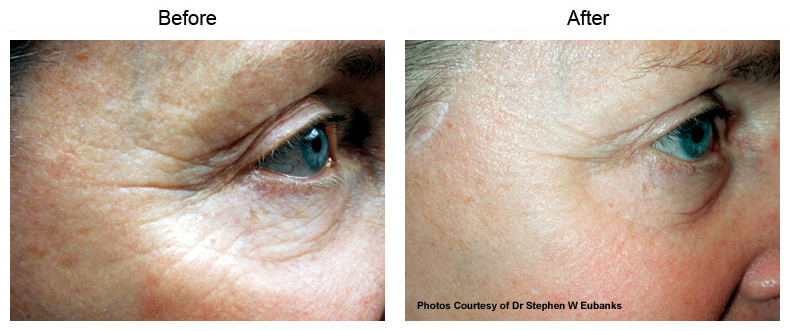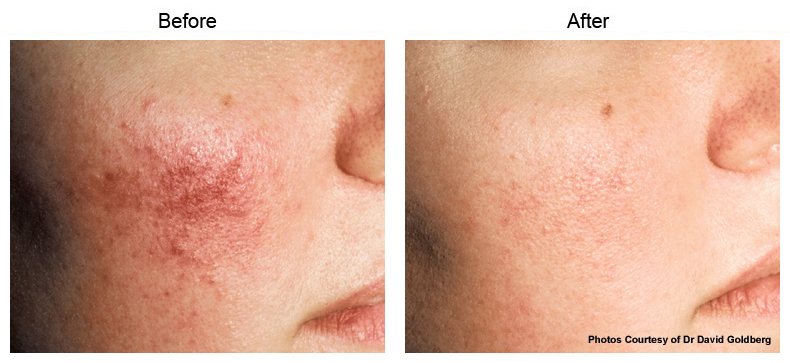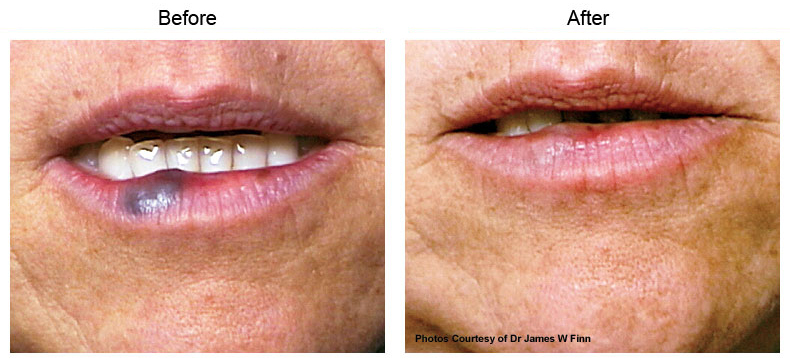Broken capillaries are very common. They usually measure only a few millimeters, and can develop anywhere on the body. They are most commonly found on the face around the nose, cheeks, and chin. They can also develop on the legs, specifically on the upper thigh, below the knee joint, and around the ankles. When it comes to treating broken capillaries & spider veins, Dr. Behroozan and his team at the Dermatology Institute of Southern California are your best bet.
Broken Capillaries & Spider Veins in Los Angeles
What are Broken Capillaries?

Capillaries connect arteries and veins, and help transport nutrients such as water and oxygen between the blood and tissue. They normally expand and contract in size all the time, similar to a rubber band being stretched. However, at times they can get dilated too much to the point that they are no longer able to return to their original smaller sizes. The capillaries stay overdilated and remain visible as a result. This condition is known as telangiectasias, or broken capillaries. They are commonly found in the face, and also the legs (known as leg veins).
These broken blood vessels are not actually abnormal in the sense that they don’t work. They still perform their normal functions of transporting nutrients with no issues. The blood vessels are simply unable to shrink down to a smaller size due to being overstretched, and do not repair themselves. This condition is not painful and is usually a cosmetic concern only, but it does make the skin look red, aged, and splotchy. A high amount of broken capillaries in the same area are frequently referred to as spider veins.
What Causes Them?
Because blood vessels expand and contract all the time, there are numerous causes that may lead to the development of broken capillaries. The concept is simple though – something excessive causes the blood vessels to get dilated too much.
Some examples are below. Because there are numerous reasons why capillaries can become overdilated, this should not be considered a complete list. A few of the common causes include:
Sun exposure
The additional heat from the sun enlarges blood vessels. Sunburns can cause the top layer of skin to peel, which then makes capillaries more noticeable. Sun damage can also lead to skin cancer.
Alcohol consumption
Light to moderate alcohol consumption causes the skin to flush due to the enlargement of vessels. Heavy drinking increases the risk of overdilation. Drinking too much too frequently can lead to spider veins. Red wine especially can also lead to inflammation.
Injuries
Bruising can lead to broken capillaries and spider veins in both, the face and legs. Even simple actions such as popping a pimple has the potential of leaving a sore spot, scarring, or a broken capillary. Certain home treatments such as DIY facial steaming are not skin friendly, and some facial scrubs can cause excessive physical trauma – especially scrubs with large grains. Treatments such as these should always be performed by a professional aesthetician, and are not advised to do on your own.
Dry and dehydrated skin
Dry skin causes the skin to become thinner and contain less tissue. This can cause capillaries and other conditions such as fine lines and wrinkles to become more visible.
Inflammation/Rosacea
Broken capillaries are very common in inflammatory conditions such as rosacea. Often, an underlying inflammatory condition such as rosacea can lead to having many telangiectasias on the face as a result of excess flushing. Similarly, autoimmune disease can also cause broken capillaries or spider angiomas.
Environmental/chemical irritants
Broken capillaries are very common during the winter. Because the body needs to use more energy to regulate temperature and preserve heat, the cold weather constricts blood vessels. Going inside someplace warm after being outside causes capillaries to rapidly dilate, and places them under a large change in pressure. Water based moisturizers can also freeze on the face in cold weather.

Certain everyday lifestyle factors can also lead to the development of broken capillaries. Some of these can be unavoidable depending on the circumstances, and others may just be a natural habit that is a part of an everyday routine. Examples of lifestyle factors that can cause overdilation are:
- Exposing your face to water that is too hot (eg: face steaming). When washing your face, use gentle warm water instead
- Rubbing eyes while crying
- Being exposed to smoking and pollution
- Being in very windy areas or places with extreme changes in weather
- Heavy consumption of acidic foods (sugar, alcohol, caffeine, processed foods, meat, dairy, refined starches)
- Blowing your nose with too much force too frequently. This puts pressure on the face
- Wearing glasses that press on certain areas of the face
- Vomiting, coughing, and sneezing. Sudden and extreme pressure from a violent sneeze or cough can break blood vessels
- Drying face too hard with towel
- Being on your feet all day – this is a very common cause of spider veins and varicose veins in the legs
- Smoking – this weakens the blood vessels and greatly increases the chances of overdilation
Candidates with Higher Risk
Some people are more predisposed to the development of broken capillaries due to genetics and other uncontrollable variables. Generally speaking, the candidates have a higher risk if they possess one of more of the following traits:
- Having sensitive skin or acne
- Genetics or a family history of having broken blood vessels/spider veins
- Fair and pale skin
- Pregnancy – this causes an increase in estrogen. These usually heal on their own after pregnancy
- Patients with rosacea. Due to excessive redness and flushing, broken blood vessels are very common
- Increased blood pressure
- Living in an area with hot weather
- Certain diseases, especially ones affecting the liver. The liver normally helps break down estrogen and progesterone. When these hormones, rise they cause dilation in capillaries
Diagnosis/Symptoms

Broken capillaries appear as a cluster of red lines near the skin’s surface. These are not painful, and are mainly an aesthetic concern. They are most often found in the face, especially in the undereye and nose regions. Spider veins are simply multiple broken capillaries in the same area. These are much more common on the legs, but can also appear on the face depending on the causes.
Broken blood vessels vary in size, and can manifest as a few small dots to lines spreading across the area. They can easily be noticed at home while looking in the mirror. As collagen decreases with aging, these can also become more visible along with other conditions such as wrinkles and age spots.
Sometimes, broken capillaries can be mistaken for acne scars instead.
This condition is generally permanent, and requires treatment in order to make it go away. It is possible for lightly damaged capillaries to heal themselves within 3-6 months time; however, anything that remains longer than that will most likely remain forever.
How Can Dr. Behroozan Treat Them?
It is very difficult to reduce the appearance of broken capillaries/spider veins on your own. There are many DIY and “natural” remedies available for personal use that might reduce the size, but the blood vessels will still remain noticeable.
Dr. Behroozan has multiple treatment options available for broken capillaries and spider veins at his two practice locations in Beverly Hills and Santa Monica. He will be able to determine whether or not these broken capillaries are a sign of any other important systemic concerns or disease. Due to the plethora of causes for broken capillaries, not every treatment option may be applicable to your case. Dr. Behroozan and the team at the Dermatology Institute of Southern California will be able to help you develop a customized treatment plan that is unique to you in order to treat damaged capillaries, as well as reduce your risk for developing new ones.
Your Treatment Options
Laser Skin Treatments
One of the most effective options available that can greatly reduce the appearance of broken capillaries in the face are laser skin treatments. The lasers are targeted directly at the blood vessel, and leave the surrounding healthy tissue intact. The laser’s light is absorbed by the hemoglobin, which vaporizes the blood and causes that capillary to collapse. The body will then naturally dissolve what is left. There is minimal downtime involved with these laser treatments, and most patients often return back to work immediately after their procedure. Laser treatments are typically a permanent solution to already damaged capillaries, but they do not prevent brand new ones from forming.
Dr. Behroozan has a variety of lasers available that are offered to patients such as the Vbeam Perfecta (pulsed dye laser). These lasers can not only reduce broken capillaries, but also simultaneously treat other conditions such as wrinkles, age spots, sun damage, and scars. At your consultation, Dr. Behroozan will help you select the correct laser that is right for you and your skin condition and type.
Microneedling
Along with lasers, microneedling is another effective treatment method for broken capillaries in the face. This procedure helps generate new collagen and make the epidermal (outer layer) of skin denser and more elastic. This treatment also has the benefit of treating other common conditions such as wrinkles, fine lines, pigmentation, and stretch marks.
Laser Leg Vein Removal
In addition to the laser options that are available for the face, Dr. Behroozan also offers lasers that can reduce the treat broken capillaries in the legs. Laser Leg Vein Removal (GentleMax) procedures are available to greatly diminish the appearance of spider veins and leg veins, and require no downtime.
Sclerotherapy for Legs
Depending on the condition of the veins on your legs, Dr. Behroozan may suggest sclerotherapy to treat your leg veins. This effective treatment involves an injection of special medicine directly into the blood vessels to improve the appearance of large spider veins and smaller varicose leg veins.
Chemical Peels
For candidates who are more prone to broken capillaries – having an experienced aesthetician perform certain facial treatments such as chemical peels is vital. This procedure builds collagen and stimulates skin regeneration while minimizing the chances of doing further damage to already broken capillaries, or breaking new ones.
Skin Care Products
Prevention is key when it comes to broken capillaries. The right facial treatments can help shrink vessels, reduce facial redness, and provide protection from external stressors. Dr. Behroozan has his own personal line of skin care products that were developed with hydrating and brightening benefits to improve your skin tone, protect against environmental damage, and keep you looking your best. These products are available at both, Beverly Hills and Santa Monica.
Frequently Asked Questions
Can broken capillaries be prevented?
Because of the variety of factors that can lead to overdilation of blood vessels, there is no 100% foolproof way to avoid them.
Certain measures can be taken to minimize them from occurring however.
Sunscreen is one of the most effective forms of protection against broken capillaries, and can stop already broken ones from becoming worse. Regular use of sunscreen also protects against other age-related concerns such as sun damage, wrinkles, and age spots. The use of sunscreen also greatly reduces the risk of developing skin cancer as well.
Vitamin C helps strengthen blood vessels. This is one of the main components in the capillary walls, and promotes collagen synthesis. Vitamin C also helps build the immune system to reduce the risk of getting sick, and thus limiting the chances of violent sneezes or coughs.
Other preventative measures include:
-Limiting sun exposure
-Avoiding extreme heat
-Alcohol in moderation
-Protective gear for injuries (eg: helmets for sports and cycling)
-Avoiding rubbing and pulling of the face
-Avoiding picking and popping of acne
What about preventing leg veins?
The measures mentioned above are great ways to help prevent broken capillaries in both the face and legs; however, for the legs, even more measures can be taken to help reduce the chances of leg/spider veins.
Weight control is a key prevention method. Too much pressure on the legs due to having a high weight can lead to spider veins, and can also damage the leg valves which leads to varicose veins. A high weight also leads to the development of higher blood pressure which can cause capillaries to become overdilated in addition to other critical health risks.
Regular exercise to improve leg strength and blood circulation is another great preventative measure. Exercises that focus on legs, such as walking or running, reduce blood vessel pressure in the legs by allowing more circulation. In addition, these exercises can facilitate the cardiovascular system and assist with weight control.
Do they go away?
This condition is generally permanent, and requires outside treatments in order to go away. It is possible for lightly damaged capillaries to heal themselves within 3-6 months time; however, anything that remains longer than that will most likely remain for good.
Overdilated capillaries as a result of pregnancy often diminish in appearance as well, but may not become completely restored and can still remain visible.
Your Next Step for
Broken Capillaries & Spider Veins
Our team is always available to answer questions and provide more information about treating broken capillaries. His office is ready and waiting to help you achieve radiant and healthy looking skin.
Before & After Photos
View before & after photos of actual patients.





Beverly Hills
9090 Burton Way Beverly Hills,
CA 90211
Santa Monica
2221 Lincoln Blvd, Suite 100
Santa Monica, CA 90405
